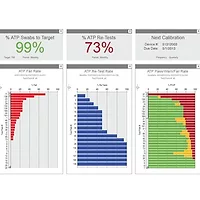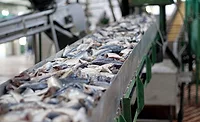Beyond the Buzz – How Food Manufacturers Realize the True Value of IIoT

The rise of the industrial internet of things (IIoT) is indisputable. In fact, the global IIoT market is expected to reach $123.8B by 2021, permeating and impacting various sectors, some more than others. Specifically for food and beverage manufacturers, this shift should already be top of mind given the industry’s potential to benefit greatly from intelligent, connected automation infrastructure. Not only can increased connectivity improve quality, safety and efficiency, while also optimizing overall production through predictive maintenance, but it can also help reduce operation costs.
However, in the midst of this hype, organizations are encountering a number of roadblocks—ranging from cost to implementation or security—that hinder them from taking full advantage of connectivity. Across all sectors, manufacturers who have successfully achieved industrial automation are exclaiming the rewards from the finish line. But few are discussing the speed bumps and challenges along this path, let alone how to overcome them. Before food manufacturers can realize the true value of IIoT, they must learn how to look past the buzz and focus on taking a step-by-step approach to implementation. Below are three ways to overcome the crossroads of connectivity.
IIoT is an Evolution, Not a Revolution
IIoT holds great promise for improving food and beverage operations, which is appealing to manufacturers eager to dive into what many are calling the “next industrial revolution” and realize these benefits as soon as possible. After all, who wants to wait to achieve safer, more efficient operations, all while reducing unplanned downtime and overall operation costs?
But before food manufacturers get ahead of themselves, they need to know where to start. Different IIoT deployment strategies will make sense for different organizations in order to best meet their particular business needs. Understanding your specific needs and developing a personalized plan to execute on will help food manufacturers avoid errors and make the shift to automated infrastructure more strategic and meaningful.
Moreover, it’s important to understand that this shift is truly more of an “evolution” than a “revolution.” The latter term suggests there will be no transitional state, which is simply unrealistic for food and beverage manufacturers. The industry cannot sustain a full-blown “rip and replace” implementation, but rather requires a more gradual shift to reaching the IIoT end goal. As such, establishing a plan that implements small, simple changes in a gradual manner will help manufacturers integrate new automation capabilities successfully, moving them toward a “smart” supply chain.
Build on Existing Investments
As part of an implementation plan, it’s important to find strategic ways to integrate and leverage existing technology and infrastructure. Connecting your devices doesn’t have to break the bank or become overly complicated. Updating your outdated operational technology systems with new, standards-based hardware and software can deliver immediate benefits around performance, reliability and cost-savings over time, moving you along the path toward IIoT. However, this can also be as simple as gradual upgrades to your existing infrastructure and finding ways to link currently unautomated production processes together.
Food manufacturers must focus on getting all their devices connected in order to allow for the bi-directional exchange of data to and from devices and sensors—and a step beyond that involves delivering that data into the cloud. The food industry currently stands at an advantage because the majority of the sensors needed to ensure product consistency are largely in place already. Therefore, food manufacturers should build on these existing sensor investments to eventually collect usable qualitative data from them to analyze food production. Due to security concerns, some food manufacturers have been slow to connect their automated devices. However, these concerns can be addressed by selecting connectivity approaches and solutions that best match existing levels of support between automation systems and the IT resources they connect with.
Looking for quick answers on food safety topics?
Try Ask FSM, our new smart AI search tool.
Ask FSM →
Ultimately, investments made in either updating or replacing your existing infrastructure will pay off in the long run due to improved production efficiency and reduced operating costs resulting from implemented automation systems.
Using Data Effectively
Many organizations face a vast amount of data from which they fail to gain any insight. Sensors on food manufacturing infrastructure collect information that is useless if unorganized or unanalyzed. However, understanding what types of data your connected machines are collecting, and learning to leverage real-time analytics and predictive tools, will enable food manufacturers to make better-informed decisions—and as a result, optimize their operations. For example, real-time analytics can detect the slightest changes in operations, allowing food manufacturers to predict whether a machine may fail and address the issue before it slows production. In addition to improving manufacturing efficiency, the insights gained by using data effectively can help increase your company’s top line growth.
Even further down the line, IIoT can help food manufacturers create a smart supply and demand chain through consumer-generated data. As “smart” IoT-enabled refrigerators—ones that allow users to automatically keep “inventory” of their food at home, view the information from their smartphones and even set automatic purchase reminders when stocks gets low—grow in popularity, the ability to monitor consumer demands grows as well. Real-time insight into these types of market shifts will enable supply chain systems to better inform product preferences, which in turn will influence manufacturers’ production, materials and distribution planning, thus eliminating unnecessary warehousing, refrigeration, transportation and inventory costs.
Getting IIoT Right
Food manufacturers have the potential to break through the buzz and intangible hype around IIoT and realize its true value—if they approach the shift strategically and learn to overcome obstacles during this transition. Establishing the right deployment strategy, connecting and leveraging your existing technology investments, and gaining actionable insights from your data are three ways in which food manufacturers can best approach automating their systems. Overcoming crossroads early on will only enable them to optimize operations and realize cost savings over time.
Jason Anderson is a food and beverage strategist at Stratus Technologies.








